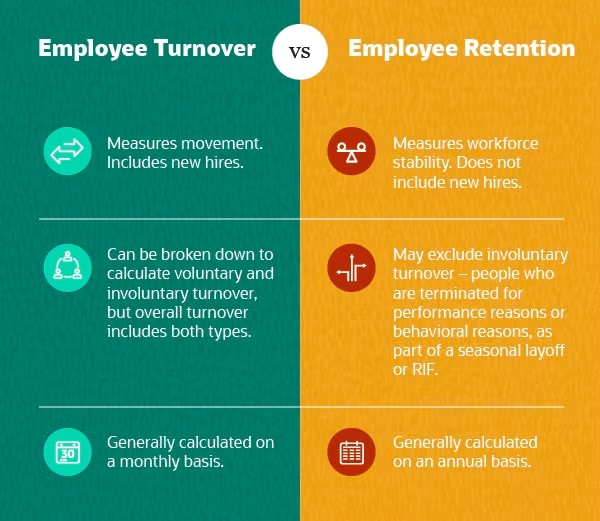Employee retention rate – A measure of success for many businesses
Employee Retention is an important part of determining the success of every organization. Calculating and tracking employee retention rates over time is an important part of helping HR understand and plan human resource development for the business.
To better understand employee retention rate and learn specific calculation methods, read this article from SMART SOLUTION FOR BUSINESS COMPANY LIMITED to grasp the knowledge and apply it in human resource management activities.
1. What is employee retention rate?
Employee retention rate is a measure of how successful a business is in maintaining a stable workforce. It shows the number of employees who stay with the organization and the total number of employees of that organization during a certain period of time.
Employee retention rate is a measure of an organization’s ability to maintain a stable workforce, thereby helping administrators understand the status of the workforce in the business and make wise decisions. to improve recruitment and employee retention strategies in businesses, specifically:
- Helps businesses orient action plans that contribute to improving employee performance.
- Understand employee satisfaction with their job and working environment
- Helps businesses stay competitive and improve their employer brand in the labor market.
How To Measure Employee Retention Success
>>>Find out more: All about labor contract services for employees and companies you need to know!
2. Why is it important to maintain a high employee retention rate?
Businesses that understand and regularly measure employee retention rates will have a better chance of retaining their talent long-term and deliver many other benefits such as the following:
- Reduce costs: high employee retention rates help businesses avoid costs that affect their revenue.
- Improve employee productivity: help businesses retain talented people who have been with and understand their business for a long time; contributes to improving work efficiency.
- Enhance organizational cohesion: build a healthier workplace culture, contributing to improved sense of community and positive spirit for the organization.
- Improve recruitment efficiency: through enhancing the organization’s employer brand.
3. The difference between employee retention rate and turnover rate
Employee retention rate and turnover rate are related metrics that businesses often use to evaluate employee engagement and satisfaction with the company. Most companies often use these two metrics together, but there are some important differences between them:
3.1 Employee Retention Rate:
- Time Frame: Based on long-term data.
- Measurement Frequency: Assessed regularly.
- Targeted Object: Measures the number of employees who choose to stay with the company.
3.2 Turnover Rate:
- Time Frame: Calculated on a quarterly or annual basis.
- Measurement Frequency: Regularly measured on a monthly, quarterly, or yearly basis.
- Targeted Object: Indicates the effectiveness of the company’s human resource policies by measuring the number of employees leaving the company. Additionally, it helps determine the reasons behind employees quitting.
Employee Retention vs. Turnover: Key Differences & Why It Matters
4. How to calculate employee retention rate
The first part of any employee retention formula is choosing the time period (depending on each organization’s business and strategy).
Before calculating employee retention rate, you need to understand the following two indicators:
Number of personnel at the beginning (B– beginning)
Number of personnel at the end (E – Ending)
To calculate the employee retention rate for that month, HR managers simply divide the number of employees at the end by the number of employees at the beginning, then multiply by 100.
Retention rate = (E/B)*100
For example: The company decided to calculate employee retention rate monthly. At the beginning of the month, the business had 200 employees and at the end of the month it reduced to 188. Plugging these numbers into the above formula we get: Retention rate = (188/200)x100= 94%
5. What does a good employee retention rate look like?
A good writer retention rate is usually 90% or higher. That means keeping turnover rates to 10% or less. At the same time, a good employee retention rate depends largely on the industry of the business and the company’s strategy.
6. How to improve employee retention rate?
6.1 Calculate the company’s index and compare with the market
Reliable sources should be consulted when comparing a company to industry standards and direct or indirect competitors. Thereby, see the business’s position in the industry and discover how the company’s employee retention strategies impact the company’s growth.
6.2 Collect feedback on employee retention
Employee surveys are a great way to get feedback from a large number of employees at once. These surveys are a valuable asset in determining whether employees are satisfied overall.
6.3 Develop an effective retention plan (based on collected data)
After receiving and analyzing feedback, plan to build a retention strategy. A business’s strategy will need to consider every aspect of the employee experience at the organization.
6.4 Recalculate your company’s employee retention rate and continue to track this metric
As you start implementing different retention strategies, evaluate these rates over a certain period of time to measure their success.
SMART SOLUTION FOR BUSINESS COMPANY LIMITED
- Address: Unit 701B-701C, Tower A, Handi Resco, 521 Kim Ma Street, Ba Dinh District, Hanoi, Vietnam
- Tel: + 84 24 3974 4181
- Email: service@s4b.com.vn
——————————————–
We Will Show You The Way To Success!


